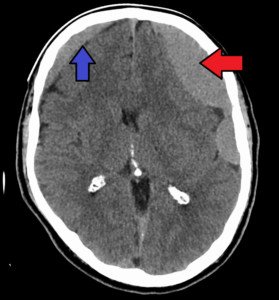
The cause of sudden weakness of an arm and leg on one side of the body isn’t necessarily a stroke.
If unexplained arm and leg weakness are happening to you, ask yourself if, in the past few months, you bumped your head or fell and hit your head — or in some way, got banged in the head — even if at the time there were no symptoms.
Dr. Irene Gatti de Leon began experiencing weakness in her right arm and leg, seemingly out of the blue.
Two months prior, she had slipped on some ice and hit her head, but at the time was able to shake it off and didn’t give it a second thought.
Two months later, when she began having weakness in her arm and leg, she didn’t make the connection.
She wasted no time getting an MRI, which revealed a chronic subdural hematoma — a large one compressing her brain.
“Chronic subdural hematoma develops over the course of weeks and sometimes, if the size is small, can cause no symptoms,” says Natasha Fuksina, MD, an internal and integrative medicine specialist who combines traditional and functional medicine to restore health and function.
“However, as the pressure from the bleeding increases it can cause symptoms such as headache, dizziness, personality changes and even progress to the weakness of the arm and leg the opposite side of the body (contralateral side).
“In severe cases, subdural hematoma can cause loss of consciousness and death if the pressure it exerts on the brain is extremely high.”
Sudden Arm and Leg Weakness on One Side: Not Always a Stroke
My mother passed out from a sudden blood pressure drop while standing at the bathroom sink, and on the way down, hit her head against the porcelain bathtub.
She wasn’t even conscious as she fell, so thus couldn’t even help break the fall.
When I heard that awful thud (I was on the lower level), I immediately knew what happened and flew up the stairs.
Unlike the Dr. Gatti de Leon case, my mother had a brain scan that very day — but it showed no subdural hematoma; it was normal.
Six weeks later she had sudden weakness in both legs, particularly the left.
If a chronic subdural hematoma is ignored, with the patient thinking that sudden arm or leg weakness is from stress or working too hard, the patient risks permanent disability — similar to that suffered from a stroke.
“The brain is covered by three layers of coverings (meninges) – dura, arachnoid and pia,” says Dr. Fuksina.
“A subdural hematoma is a collection of blood outside of the brain — between the outermost layer (dura) and the middle layer (arachnoid).”

Subdural hematoma. James Heilman, MD
An acute subdural hematoma is immediately life-threatening, since the bleeding is rapid.
A chronic subdural hematoma leaks blood very slowly over time, which is why the patient can go weeks without symptoms, and then literally awaken one day with significant arm and leg weakness.
Neurological symptoms should never be ignored.
If you have sudden or even gradual weakness of an arm and leg, especially on one side of the body, seek immediate medical attention; insist on a brain scan.

 Dr. Fuksina
Dr. Fuksina







































